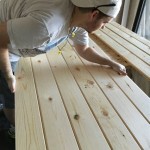How to Fix Interior Door Scratches
Interior doors are prone to scratches from everyday use. From furniture bumping against them to pets brushing past, these marks can detract from the overall appearance of your home. Thankfully, fixing interior door scratches is a relatively easy and inexpensive task. With the right tools and a little patience, you can restore your doors to their former glory.
The first step is to assess the severity of the scratches. Minor scratches can often be treated with simple methods, while deeper gouges may require more involved repairs. Once you have determined the extent of the damage, you can choose the appropriate repair technique.
1. Using a Pencil to Fill Scratches
For shallow scratches, a simple pencil can be a surprisingly effective tool. Choose a pencil that matches the color of your door as closely as possible. Lightly color the scratch with the pencil, applying gentle pressure. The pencil lead will fill in the scratch, effectively disguising it.
This method is ideal for scratches that are only visible upon close inspection. It is particularly effective on painted doors, as the pencil lead blends in seamlessly with the paint. However, it may not be suitable for deeper scratches or those on wood doors with a natural finish.
2. Applying Wood Filler
For deeper scratches, wood filler is a more robust solution. Choose a wood filler that matches the color of your door, and apply it to the scratch using a putty knife. Ensure the filler is spread evenly and fills the entire scratch. Allow the filler to dry completely before sanding it smooth. This will create a seamless surface that blends in with the rest of the door.
Wood filler can be used on both painted and natural wood doors. However, it may require more time and effort for sanding, especially on doors with intricate details or delicate finishes. It is essential to choose a filler that is compatible with the type of wood and paint used on your door.
3. Repairing Deeper Scratches with Wood Putty
When faced with deeper scratches or gouges, wood putty provides a more durable solution. Wood putty is a mixture of fillers and binders designed to adhere to wood and create a solid surface. It is available in various colors to match different wood tones.
Apply the putty to the scratch with a putty knife, ensuring it completely fills the groove. Let the putty dry completely, then sand it smooth with fine-grit sandpaper. To ensure a seamless finish, match the wood grain pattern by applying light strokes with a paintbrush or putty knife.
Wood putty is a versatile solution that can be used on both painted and natural wood doors. However, it requires more time and effort for sanding and matching the grain pattern. It is crucial to use the appropriate type of putty for your door and ensure it is compatible with its existing finish.
4. Using Touch-Up Paint
Scratches on painted doors can often be concealed with touch-up paint. Choose a paint that closely matches the original door color. Apply a small amount of paint to the scratch using a fine-tipped brush. Avoid applying too much paint, as it may create an uneven surface. Allow the paint to dry completely before sanding it smooth with fine-grit sandpaper.
This method is quick and easy, especially for minor scratches. It is particularly effective for painted doors, as it blends seamlessly with the existing paint. However, it may not be suitable for deeper scratches or those on doors with intricate finishes. It is essential to choose a paint that is compatible with the original door paint, ensuring a lasting finish.
5. Applying a Wood Stain
Scratches on natural wood doors can be disguised using a wood stain. First, clean the scratch with a damp cloth and allow it to dry completely. Apply a small amount of stain to the scratch with a fine-tipped brush. Ensure the stain matches the existing finish of the door. Let the stain dry completely and apply a coat of polyurethane for protection.
This method is ideal for scratches on doors with natural wood finishes. However, it requires careful application and may not be suitable for deeper scratches or those on doors with intricate details. Ensure the stain matches the existing finish of the door to maintain a consistent appearance.
6. Using Furniture Polish
Furniture polish can be a quick and simple solution for minor scratches on both painted and natural wood doors. Apply a small amount of polish to a soft cloth and rub it gently over the scratch. This will help to fill in the scratch and improve the overall appearance of the door.
This method is best for minor scratches and may not be effective for deeper ones. It is a quick and convenient solution, especially for those who prefer a less involved approach. However, it may not provide a lasting solution for more prominent scratches.
By following these steps and choosing the appropriate method based on the severity of the scratch, you can effectively repair interior door scratches and restore the beauty of your door. Remember to always test the repair technique on an inconspicuous area of the door before applying it to the entire scratch. This will help ensure a successful outcome and maintain the aesthetic integrity of your home.

How To Fix Scratched Interior Panels In Your Car Holts Auto Site

How To Repair Car Interior Scratches Sc And Blemishes Motors Blog
How To Remove Scratches From A Car S Interior Ifixit Repair Guide

How To Remove Scratches On Interior Doors Skyscraper Window Cleaning

How To Clean Scuff Marks On Your Door Panel
How To Remove Scratches From A Car S Interior Ifixit Repair Guide
How To Remove Scratches From A Car S Interior Ifixit Repair Guide

How To Re Scratched Gloss Black Trim
How To Remove Scratches From A Car S Interior Ifixit Repair Guide

Removing The Scratches From A Luxury Car S Interior Trim Cars 101
Related Posts








